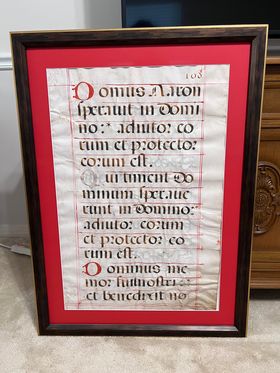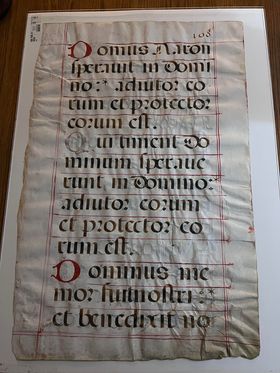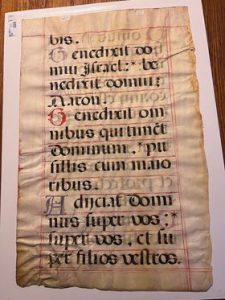A Detached Folio 108 with Part of Vulgate Psalm 118 (117)
June 18, 2022 in Manuscript Studies
A Leaf on Vellum with Part of Vulgate Psalm 118 (117)
Collection of Stephen Soderlind
Single leaf from a large-format manuscript in Latin
Single Columns of 14 Lines
Circa 29 1/2 × 19 1/4 inches <written area circa 25 1/4 × 14 1/4 inches>
Psalm 118 (117):18–22 (Domus Aaron sperauit . . . super filios uestros)
Folio “108”
Single column of 14 lines in Gothic Bookhand
with embellishments in red pigment
(bounding lines, ruled lines, and initials)

Collection of Stephen Soderlind, Single Leaf in Frame as purchased: Front of Frame. Reproduced by Permission.
[Posted on 18 June 2022]
Continuing our series of brief reports about stray manuscript leaves which emerge in various collections — as the leaves move from one to the next, and as collectors reach out to us with images, information, and questions about their materials, and wish to share them with a wider world — we report a new find from an estate sale.
The large leaf now belongs to the Collection of Stephen Soderlind. It arrived in a plain frame with a windowed red mat, which overlay the outer edges of the leaf and held it in place, as if cropped.
Within the window, the arabic number 108 in a modern hand at the top right above the single column of text appears within view. Without the chance to see the other side of the leaf, hidden within the frame, it remained uncertain whether the number serves as the folio number (for one side of the leaf) or the page number (for this side of the leaf in particular, reserving another number for the other side).
The back of the frame holds little information.

Collection of Stephen Soderlind, Single Leaf in Frame as purchased: Back of Frame. Reproduced by Permission.
Released from the frame, the wrinkles and creases in most parts of the leaf are characteristic of vellum subjected to humid conditions for an extended period, without the stretching under pressure while drying requisite to produce, or reinstate, the smooth surface of vellum or parchment. The wrinkles visible through the glass of the former frame indicate that the leaf as displayed and stored therein pertain to that stage in the life of the leaf, if not already before.
Closer examination yields further information about the leaf and its genre of book. We examine both sides of the leaf, consider some features in detail, and open the discussion for analysis of the probable place and date of origin. We invite your observations and suggestions.
The Front-Facing Page
Written in short lines, the text on this page presents most of three verses from Psalm 118. The page begins with Verse 18 and extends to halfway through Verse 20, breaking off mid-word.
[18] Domus Aaron / sperauit in domi-/no:* adiutor eo-/rum et protector / eorum est. /
[19] Qui timent Do-/minum speraue-/runt in Domino:* / aduitor eorum / et protector eo-/rum est.
[20] Dominus me-/mor fuitnostri [run together as a single word]:* / et benedixit no-/

Collection of Stephen Soderlind, Single Leaf, Recto, outside the Frame. Reproduced by Permission.
The Formerly Hidden Side
The text on this page picks up where the other side leaves off. It completes Verse 20, and continues through the end of Verse 22. There is no page number at the top. Evidently this side is the original Verso, the other side is the original Recto, and the number on that side is the folio number.
-bis.
Benedixit domui Israei:* be-/nedixit domui / Aaron.
[21] Benedixit om-/nibus qui timent / Dominum . pu-/sillis cum maio-/ribus.
[22] Adijciat domi-/mus super vos :* / super vos, et su-/per filius uestros.

Collection of Stephen Soderlind, Single Leaf, Verso. Reproduced by Permission.
Features of Script and Layout
The grid or armature for each column of text comprises a ladder-like structure of horizontal and vertical lines ruled in red pigment. Single lines form most of the rungs of the ladder, while its top and bottom line as well as both sides are ruled in pairs of narrowly spaced parallel lines. The first line of text in the column stands below the ruled top line. On the significance of that positioning for dating scripts, see, for example:
Simply put (see “Mise-en-page” in the Glossaries for the British Library Catalogue of Illuminated Manuscripts):
Another important development was the standard adoption of a layout wherein the top line of text was written ‘below top-line’ rather than ‘above top-line’ of the ruling, a change that appeared around 1220–40 and which acts as a useful criterion for dating manuscripts.
The enlarged Verse Initials stand within the columns, but their height extends both above and below the ruled confines. One initial (A of Adijciat on the verso) also extends to the left, reaching partway into the ladder with the rounded tip of its foot.
These initials comprise Gothic Capitals with built-up bodies and appendages, with simple decoration in the forms of curved hooks or bulb-like tips. The horizontal “waist” of the A of Adijciat comprises a pair of parallel lines resembling the ladder-like rungs of the ruled grid. From one to the next
, the Verse initials alternate between red pigment and a darker or darkened pigment, which appears purple in some cases.
The script exhibits some distinctive features, as with the forward-leaning r (as in adiuitor, protector); the e resembling a c with a high, diagonal tongue; letters sometimes pressed together (as with p and e in sperauerat in Verse 19); and the asterisk (*) following some punctuation marks (:* / ;* / .*).
Further study of the script and its relatives might help to identify the probable place and origin of the manuscript. Identifying the type, or probable type, of book could depend upon other contextual elements which would reside in other parts of the manuscript itself or in comparable copies.
The Former Book
The text of the Book of Psalms, or part of it, could indicate more than one form of book. For example, a Psalter as such would contain the text of the Psalms and sometimes also accompanying material of various kinds. The Psalms, or parts of them, could occupy a place within copies of the Bible, Lectionaries, Breviaries, and other genres.
The size of the leaf rules out some forms of books with the text of Psalms in whole or in part, such as Books of Hours.
The large size of the leaf and its expansive, formal layout in verses and short lines, implies an intention for display, for example on a lectern, and for reading aloud from it in public performance of liturgical ritual. Had it musical notation, the intention would call for recitation by singing or chant. On the widespread use of the Psalms and the Psalter in Latin liturgical practice, see, for example, Latin Psalters.
The uneven or ragged contour of the inner edge of the leaf implies that the leaf was forcibly removed at knife-point from its book and any conjoint leaf. The stains and dirt along the outer edges appear to indicate exposure across time.
The modern folio number 108 demonstrates that, if the numbering was correct in its sequence, 107 leaves formerly preceded it; who knows now how many leaves followed it, although further research might reveal an answer. The modern numbering, evidently placed within the book before the dismemberment, appears to show use of the book as a unit, whether to continue to consult its contents, or only to record its numbers, say for sale, before dispersing its members.
Next steps in the investigation could consider which portion(s) of the religious service of the Divine Office, or occasion(s) of the liturgical year and time(s) of day in the Latin liturgical rites, would employ ceremonial readings from this part of Psalm 118 (117 as numbered in the Latin Vulgate).

Private Collection, MS 1, Leaf 2 of 2. Fol. 137r with guide. Photography Mildred Budny. Reproduced by permission.

Private Collection, MS 1, Leaf 1 of 2. Folio 130 recto
, with Guide. Photography Mildred Budny. Reproduced by Permission.
For example, our blog has previously published a pair of leaves from a large-format Latin manuscript with parts of the Vulgate Psalms in a Private Collection. One leaf contains part of the Vulgate Psalms (83:11 – 84:12), while the other contains several texts for Friday Matins in the Divine Office, including the Hymn Tu Trinitatis Unitas, the Antiphon Inclina Domine, and Psalm 86:1–12.
On its own, the leaf with the text of consecutive Psalms alone could call into question what form of manuscript it graced. However, because the collection preserves two non-consecutive leaves from the dismembered manuscript as a pair, the contents and sequence of the texts on the other leaf allow for a chance to conjecture what book was involved. In this case, the combination of texts on the preserved sample illuminates the nature of the purpose and function of the former book.
Date and Place of Origin for the Manuscript
We invite your suggestions. What do you think?
*****
We thank Stephen Soderlind for sharing information and images of this leaf, and for answering queries about its features, source, and other aspects.
*****
Do you know of more leaves from this manuscript? Do you recognize the hands of the scribe in other parts of this book or in other manuscripts?
You might reach us via Contact Us or our Facebook Page. Comments here are welcome too. We look forward to hearing from you.
Watch our blog on Manuscript Studies for more discoveries. Please visit its Contents List.
*****
